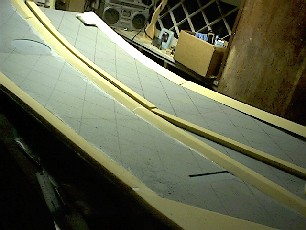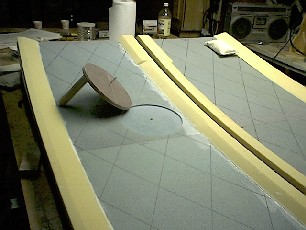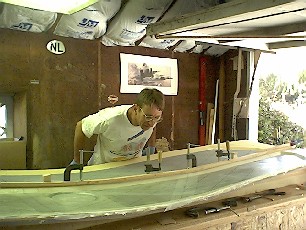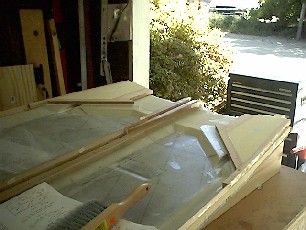Chapter 5 Fuselage Sides
Sunday Dec 8, 2002

 Here are some pictures of the longerons clamped up in the jigs. It's a little difficult to see but at this point each longeron is made up of three strips of spruce glued together to make the outer curvature of the fuselage. For me the hardest part was to make dimensionally accurate jigs. To make an angled cut on the 1 X 8 pine proved to be challenging. My table saw was too small to use an angled fence guide. So it was back to the Skilsaw with an aluminum straight edge as a guide. Well my straight edge bowed as I cut so I ended up with a curved cut and the offset wasn't quite accurate so I didn't get exactly 1.5 inches at the narrow end. Drilled some holes in the straight edge and screwed in down to the wood and positioned it accurately for the Skilsaw offset. After turning a stack of 1X8s into sawdust I finally ended up with some jigs that I was happy with. I covered the workbench with plastic and covered the jigs with clear packing tape so the longerons wouldn't be permanently bonded. I also covered the contact points of the clamps with tape to prevent bonding. The epoxy flows everywhere so it's better to be overly cautious. I already had a lot of clamps from building the kayak but I picked up a few more from Harbor Freight, these go on sale quite often for 50% off and only cost $3.00 to $4.00. The clamps work much better that using nails as called out in the plans, I actually did both since the clamps tended to slide on the angled surfaces so I drove nails into the table where I had the clamp to keep it in position. The jigs themselves are screwed down to the table on top of the plastic with a half inch gap at the ends to account for the thickness of the foam fuselage sides.
Here are some pictures of the longerons clamped up in the jigs. It's a little difficult to see but at this point each longeron is made up of three strips of spruce glued together to make the outer curvature of the fuselage. For me the hardest part was to make dimensionally accurate jigs. To make an angled cut on the 1 X 8 pine proved to be challenging. My table saw was too small to use an angled fence guide. So it was back to the Skilsaw with an aluminum straight edge as a guide. Well my straight edge bowed as I cut so I ended up with a curved cut and the offset wasn't quite accurate so I didn't get exactly 1.5 inches at the narrow end. Drilled some holes in the straight edge and screwed in down to the wood and positioned it accurately for the Skilsaw offset. After turning a stack of 1X8s into sawdust I finally ended up with some jigs that I was happy with. I covered the workbench with plastic and covered the jigs with clear packing tape so the longerons wouldn't be permanently bonded. I also covered the contact points of the clamps with tape to prevent bonding. The epoxy flows everywhere so it's better to be overly cautious. I already had a lot of clamps from building the kayak but I picked up a few more from Harbor Freight, these go on sale quite often for 50% off and only cost $3.00 to $4.00. The clamps work much better that using nails as called out in the plans, I actually did both since the clamps tended to slide on the angled surfaces so I drove nails into the table where I had the clamp to keep it in position. The jigs themselves are screwed down to the table on top of the plastic with a half inch gap at the ends to account for the thickness of the foam fuselage sides.
Sunday Apr. 14, 2003
I got a little side tracked over the holidays with some other projects, primarily automotive repair and building a radio controlled electric glider. The glider was about a 4 week quick fix to satisfy the urge to build and fly something, besides the kit was only $23.00, couldn't resist. My other brother-in-law, Max, got interested in electric gliders and thought it would be good to get his boys (my nephews) interested in airplanes, so I had to build something too.
Well I haven't been totally idle on the Cozy, I built the jigs for the fuselage sides and 5 minute expoxied the blue 3/8 inch thick foam panels together (the hinge method) to achieve the 102 inch length per side and tacked the foam panels down to the masonite jigs with 5 minute epoxy. I thought about other methods builders have used to avoid the divots when the sides are pulled of the jigs but then I thought this is quick and easy and per the plans. I did follow Rick Maddy's suggestion of leaving about an extra 1/4 inch of foam along the curved bottom and letting some excess foam hang over the front end to account for the slope of the side. I made an 8 inch diameter sanding disk to make the depression for control stick clearance. It has a nail in the center and I drilled a hole throught the foam and masonite at the proper location and spun away. Becareful when drilling the hole through the masonite, it has the tendency to pop through all at once which caused me to push the nose of the drill chuck into the foam. Now I'll have to fill that hole with micro. I also started the fuel sight gage depression in the back. I still have to call Vance Atkinson and order the sight gages.



All this seems pretty straight forward after you're done doing it, but while in the process of measuring, cutting and sanding I panicked myself several times thinking I had done something wrong. Sometimes I did but it could be easily fixed. I guess what I'm finding out for myself is that each time I work on the airplane I should approach it without any expectations, because PATIENCE is everything to getting things done right. When I read the plans and look at other builders websites it seems like everything is so easy that each step is a 10 minute job. Making all those doublers that go around the perimeter of the sides probably took me two solid days. With the changing bevels and the large doubler at the aft end I pondered for quite awhile on how to do that. I ultimately used a sanding board to make the bevels. I probably could have used my band saw and it would have gone faster but my experience with power tools so far is that I end up cutting a lot of material into useless scraps. So going slow and doing things by hand is my method of operation right now. I find I enjoy the building a lot more that way.
Sunday May 25, 2003
After fussing with the control stick and fuel sight gage depressions some more and cutting in the electrical conduit channel I decided to do one of the fuselage side layups. Plans say you can do both sides at the same time in about 3 to 4 hours, well, it took 6 hours with the help of my wife Lynn to do the one side. There were no real surprises while doing the layup it just took a long time. I had the usual difficulty in getting the cloth to lay down in the control stick depression, used some Saran Wrap to help with that. Didn't really care for the final result though, since the Saran wrap creates a smooth shiny surface finish while every else the finish is the weave of the cloth. In bonding the upper longeron in place I made sure I got a good squeeze out of flox to ensure there were no voids. Other than than you just need to make sure you peel ply anywhere parts may be bonded in the future.



Sunday Aug. 3, 2003
I've done a lot more than I can remember; I really need to keep up with the documentation a bit better. But I did the 4 ply UNI layup on the upper longerons. My first attempt at this was a big mistake. I thought it would be easier to wet out the four plies first on a flat table and then lay the wetted out 4 plys on the longeron. This way the cloth would not get distorted and the fibers would lay straight and beautiful. Well the problem was that by the time I got all four plys wetted out the epoxy in the first ply started to kick in and become thick. When I layed the four plys on the longeron and started working it into the corners I got a lot of bubbles, I worked for hours to get the bubbles out and thought I did a good job, but the next day when I looked at it there were 2 or 3 bubbles that were smaller than an inch in diameter, so OK to leave as is, but I was not happy with it. So I carefully sanded it all off, took about 2 days to do it. Started sanding by hand and after a couple of hours realized I was barely scratching the surface, so I got out the trusty Fein sander and then started to make progress. I figured this would help me learn about making a repair, this also taught me to listen to the little voice in the back of my head telling me when something is going wrong and to stop before I really regret it. I knew when I was feverishly trying to work out all those bubbles that this was not right but I continued on anyway because I didn't want the days work to go to waste. It is so much easier to pull off an uncooperative layup and throw it away, than it is to sand it all off after it's hardened. I probably didn't really need to do all that, but I feel a lot better for it. Didn't manage to take any pictures of this whole ordeal.
The four ply layups on the upper longerons were done one ply at a time, I still needed to work out some bubbles and coerce it to stay in the corners but in the end there were no bubbles. Satisfaction!
The second side layup went pretty quick, the next day though I noticed a couple of small bubbles. These bubbles are going to give me a heart attack. It's funny, with light shinning right on them I couldn't see them, then with dim side light I could see two small areas that looked lighter in color. Of course you notice them after the layup has cured. Lynn is much better at seeing the bubbles than I, her half of the layup was perfect. The bubbles looked to be larger than an inch in diameter so I emailed Nat to see if I needed to do a traditional repair by sanding the area 1 inch per ply larger than the void and laying up new glass, this would end up being a large area. Nat emailed back, within an hour, on a Sunday! Can you believe it, considering the number of Cozy builders out there is quickly approaching 2 thousand, all over the world! Amazing!(You'll never be able to use Nat as an excuse for delaying the building of your airplane.) He said that filling the bubble with epoxy would be fine. To do this you drill two small holes in the bubble, one to fill with epoxy using a syringe and the other to let the air escape. Before I did this I tapped the area with a quarter (a thud sound indicates a void or delamination, a crisp solid sound is a good layup) and determined that the larger bubble was really only about 3/4 inch in diameter and the second bubble was about a 1/2 inch. But I did the repair and it worked great.
The next step was to bond the lower longerons to the bottom of the sides. I ran into the same problem here as Rick Maddy, for some reason when measuring the exact position of the lower longeron, it hung over the edge a bit. So before bonding it on I microed on a 1/4 inch strip of foam to the bottom edge and glassed it, tying it into the glassed side. After making some cuts in the lower longeron to allow it to conform to the curved sides I could bond it on without any of it hanging over. Wooden doublers get floxed on to the aft ends of the lower longeron where the sides get reinforced with wood stiffeners (LWX & LWY) and 6 plies of glass. This area is reinforced because the landing gear bulkheads are attached here and it also supports the wing spar.
The two wood stiffeners LWX and LWY were bonded in the proper position to provide the necessary dimensions for the wing spar cutout. Here I cut the angles on LWX and LWY so that they intersected at the appropriate location for the wing spar cutout. This was slightly different from the 45 degree angle called out in the plans which would not allow LWX to meet LWY at the correct location, so we'll see if this causes any problems when attaching the landing gear bulkheads, I don't think it should. LWX and LWY also received a ply of BID tape in the corners to further tie them into the glass sides.
I trimmed the previously fabricated electrical channels to the correct height, it stood a little tall since the lower longeron is only .7 inches high and it was made using 3/4 inch foam core. Anyway, it was 5 minute epoxied in place and foam was microed in the area bounded by LWX and LWY. After the micro cured I sanded the area flat in preparation for the 6 ply BID layup. It was a little difficult to sand flat since the micro is so much harder than the foam which results in high spots wherever there is micro. So I used a flat file to file down the micro. The six ply layup of BID over the area was easy and satisfying.





 Did the cutout for the wing spar and at this point the sides are essentially done. On to Chapter 6 to get these things to fit together.
Did the cutout for the wing spar and at this point the sides are essentially done. On to Chapter 6 to get these things to fit together.
Return Home Chapter 4 Bulkheads Chapter 6 Fuselage Assembly

 Here are some pictures of the longerons clamped up in the jigs. It's a little difficult to see but at this point each longeron is made up of three strips of spruce glued together to make the outer curvature of the fuselage. For me the hardest part was to make dimensionally accurate jigs. To make an angled cut on the 1 X 8 pine proved to be challenging. My table saw was too small to use an angled fence guide. So it was back to the Skilsaw with an aluminum straight edge as a guide. Well my straight edge bowed as I cut so I ended up with a curved cut and the offset wasn't quite accurate so I didn't get exactly 1.5 inches at the narrow end. Drilled some holes in the straight edge and screwed in down to the wood and positioned it accurately for the Skilsaw offset. After turning a stack of 1X8s into sawdust I finally ended up with some jigs that I was happy with. I covered the workbench with plastic and covered the jigs with clear packing tape so the longerons wouldn't be permanently bonded. I also covered the contact points of the clamps with tape to prevent bonding. The epoxy flows everywhere so it's better to be overly cautious. I already had a lot of clamps from building the kayak but I picked up a few more from Harbor Freight, these go on sale quite often for 50% off and only cost $3.00 to $4.00. The clamps work much better that using nails as called out in the plans, I actually did both since the clamps tended to slide on the angled surfaces so I drove nails into the table where I had the clamp to keep it in position. The jigs themselves are screwed down to the table on top of the plastic with a half inch gap at the ends to account for the thickness of the foam fuselage sides.
Here are some pictures of the longerons clamped up in the jigs. It's a little difficult to see but at this point each longeron is made up of three strips of spruce glued together to make the outer curvature of the fuselage. For me the hardest part was to make dimensionally accurate jigs. To make an angled cut on the 1 X 8 pine proved to be challenging. My table saw was too small to use an angled fence guide. So it was back to the Skilsaw with an aluminum straight edge as a guide. Well my straight edge bowed as I cut so I ended up with a curved cut and the offset wasn't quite accurate so I didn't get exactly 1.5 inches at the narrow end. Drilled some holes in the straight edge and screwed in down to the wood and positioned it accurately for the Skilsaw offset. After turning a stack of 1X8s into sawdust I finally ended up with some jigs that I was happy with. I covered the workbench with plastic and covered the jigs with clear packing tape so the longerons wouldn't be permanently bonded. I also covered the contact points of the clamps with tape to prevent bonding. The epoxy flows everywhere so it's better to be overly cautious. I already had a lot of clamps from building the kayak but I picked up a few more from Harbor Freight, these go on sale quite often for 50% off and only cost $3.00 to $4.00. The clamps work much better that using nails as called out in the plans, I actually did both since the clamps tended to slide on the angled surfaces so I drove nails into the table where I had the clamp to keep it in position. The jigs themselves are screwed down to the table on top of the plastic with a half inch gap at the ends to account for the thickness of the foam fuselage sides.











 Did the cutout for the wing spar and at this point the sides are essentially done. On to Chapter 6 to get these things to fit together.
Did the cutout for the wing spar and at this point the sides are essentially done. On to Chapter 6 to get these things to fit together.